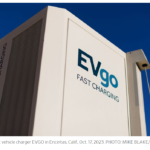Energy News Beat
In yet another example of Biden incompetence, the administration is setting up rules making it harder to deliver EV charging stations.
Politicizing EV Charging Stations
The Wall Street Journal comments on The Politicized EV Charger ‘Revolution’
The government rollout of EV chargers has been a slow-motion affair, and as you’d expect the reason is politics. The feds are throwing billions of dollars to build charging stations, but they’ve added social-justice and union mandates that make the build-out more complicated than necessary.
It’s the latest payout from $7.5 billion in funding from the 2021 infrastructure spending blowout. Transportation Secretary Pete Buttigieg spoke of handing out the money as a triumph in itself; “We have a chance to lead the world in the EV revolution.”
But the revolution’s been a long time coming. Despite the $2 billion of subsidies already authorized, only two federally funded stations have opened.
The bureaucrats are getting in their own way. The FHWA issued a rule requiring that workers for most projects be certified by the electricians union, or another government-approved training program.
States have also blasted the program for its lack of flexibility. Florida’s Transportation Department said projects were stifled by guidance that stations be 50 miles apart. Pennsylvania lamented restrictions on building stations with fewer than four charging ports. Idaho, Montana, the Dakotas and Wyoming all begged for relief from the Buy America requirement for steel and iron components, which the agency waived temporarily last year.
The latest funding comes with rules that will make sure charging station customers are even scarcer than workers. Half of the grant money is set aside for “disadvantaged communities that are marginalized by underinvestment,” which by the agency’s description includes Alaskan and Arizonan Indian tribes and urban parks and libraries.
Half of the money will be spent where no one can afford an EV.
NADA Market Beat 2023 Numbers
Light Vehicle Sales: 15.46 million
EV sales: 1.1 million (actually 1.2 million)
EV sales 7.12 percent
There are about 292 million vehicles on the road according to Hedges. That number does include medium and heavy duty trucks.
Cars last about 13 years on average.
Edison Electric Institute Projections
The EEI Projects 26.4 Million Electric Vehicles Will Be on U.S. Roads in 2030.
The number of EVs on U.S. roads is projected to reach 26.4 million in 2030, up from the projected 18.7 million in the 2018 report.
The projected 26.4 million EVs will make up nearly 10 percent of the 259 million light-duty vehicles (cars and light trucks) expected to be on U.S. roads in 2030.
Nearly 12.9 million charge ports will be needed to support the projected 26.4 million EVs that will be on U.S. roads in 2030. [Biden added 2 stations, perhaps 8-10 ports]
Approximately 140,000 DC fast charging ports will be needed to support the level of EVs expected to be on U.S. roads in 2030.
It took eight years to sell one million EVs and fewer than three years to sell the next million. EEI projects the next one million EVs will be sold by the end of 2022.
That last line is interesting. What happened to the rate of growth? In 2023 only 1.2 million sold.
The Math
There are about 1.7 million total EVs in the US out of 292 million vehicles. That is a penetration rate of 0.58 percent.
Let’s add another 1.1 million for 2024. That will bring the total to 2.8 million or about 0.95 percent.
If we just count light vehicles, by 2030 EVs will be about 10 percent, assuming the EEI projections hold, but they already missed 2023.
Only 6 Percent in the US want an EV for their Next Vehicle
Yesterday, I wrote Only 6 Percent in the US want an EV for their Next Vehicle
Demand for EVs is crashing in the US. Only six percent want an EV for their next vehicle but 67 percent want an ICE up from 58 percent last year.
I should have said the rate of increase in demand is crashing. But it’s possible the statement is accurate as is. We will know in a year.
Eight Inconvenient EV Truths
EVs are more expensive
EVs are inconvenient for anyone who needs a public charger
EVs are inconvenient for anyone who drives long distances
Insurance costs are higher
Maintenance costs are higher
Repairs take longer and parts are in short supply
Minor accidents can be very costly requiring a new battery
Consumers don’t want the damn things and rightfully so
Several readers moaned about point 8.
Adoption Rate
One of my readers commented “1.2 million people bought one this year.”
Another commented “Every EV sold is not an ICE sale.” Brilliant!
A third commented “If 1.2 million in one year is a close approximation of nothing, I’ll concede defeat.“
That comment is interesting because I never used the word “nothing” in my article. I did say consumers don’t want the damn things while pointing out 6 percent do. So “nothing” is quite a bit out of context.
I do not believe 6 percent is a lot, and if that’s accurate, it’s down from about 7.12 percent.
EVs sales are exploding! Growth is phenomenal! Hooray!
Note when numbers are tiny, always refer to percentage growth to make things look better.
1.2 million is a 250% growth rate according to a Hertz report (The irony is staggering). Will there be any growth in EV sales in 2024?
Assume 50 percent growth. That would put another 1.8 million EVs on the road making a total of about 1.2 percent. That’s greater than nothing (a word I did not use) by 1.2 percentage points.
What About Insurance?
Some readers objected to my point about insurance being higher. MoneyGeek reported the costs are about the same on average down from a 15 percent premium two years ago.
But it also says “Of the electric vehicle models that had corresponding combustion models, MoneyGeek found that most electric vehicles had higher insurance premium costs, ranging from 3% to 12% more expensive than their combustion counterparts. The only exception was the Ford Mustang Mach E, which is 18% cheaper to insure than its combustion counterpart, the Ford Mustang.”
I have no idea why Mustang would be different. Also, “Teslas are amongst the most costly electric vehicles to insure. MoneyGeek’s analysis found that four of the five electric cars with the highest insurance costs were Teslas.”
Most of the EVs on the road are Teslas.
Kelley Blue Book reports “Even though they don’t run on fossil fuels or require oil changes, and they have fewer moving parts to break, electric vehicles cost more to buy than their internal-combustion counterparts. Since they tend to cost more, they cost more to insure.“
What About Repairs?
Kelley Blue Book reports “Generally, higher-priced vehicles cost more to insure because they also cost more to repair or replace. Today’s electric vehicles also have fewer moving parts than conventional automobiles, but those parts can be pricey. If the battery pack is damaged, certain safety protocols are often necessary, adding more to the repair bill.”
The report adds, “There aren’t as many shops with technicians trained to fix electric vehicles versus traditional vehicles. That means those qualified facilities may charge more for repairs because of the specialized training required.”
The report was a reference to Hertz. I cannot verify the claim of Hertz. But to me it makes sense. If you need a repair, it’s likely to be more expensive.
Actions Speak Louder Than Projections
The adoption rate of EVs, actions by Hertz, actions by GM, action by Ford, and survey of intensions speak loud and clear.
That is despite massive incentives, subsidies, and outright coercion in California.
Hertz Is Selling 20,000 EVs Due to Lack of Customer Demand
On January 11, I noted Hertz Is Selling 20,000 EVs Due to Lack of Customer Demand
Hertz said Thursday that it would sell about 20,000 EVs in the U.S., and use some of the proceeds to purchase internal-combustion-engine vehicles. The company in a regulatory filing cited weaker demand for electrics, and their higher operating costs.
The company said it would log a $245 million incremental net depreciation expense related to the sale of the 20,000 electric vehicles.
Do you believe actions or what you want to hear?
Front-End Collision Hoot of the Day
Reuters noted “Hertz even limited the torque and speed on the EVs and offered it to experienced users on the platform to make them easier to adapt after certain users had front-end collisions.“
Hertz has to limit the speed to prevent crashes. What a hoot.
EV Expectations and Repair Costs
Morgan Stanley analyst Adam Jonas said in a note Hertz’s move was another sign that EV expectations need to be “reset downward”.
While consumers enjoy the driving experience and fuel savings (per mile) of an EV, Jonas said there are other “hidden costs to EV ownership“.
“Expenses related to collision and damage, primarily associated with EVs, remained high in the quarter,” Hertz said in a regulatory filing on Thursday.
The company, which had earlier planned to order 100,000 Tesla vehicles by 2022 end and 65,000 units from Polestar over five years, said it would focus on improving profitability for the rest of its EV fleet.
Despite Huge Incentives, Supply of EVs on Dealer Lots Soars to 92 Days
On July 13, 2023, I noted Despite Huge Incentives, Supply of EVs on Dealer Lots Soars to 92 Days
EV inventory is piling up on dealer lots. Hello car manufacturers, what are you going to do with all that inventory?
Firm Answer to My July 13 Question
October 24, 2023: GM Scraps EV Target, Ford Scales Back Electric Trucks, Musk Warns of Challenges
To Shore Up Share Price, GM Decreases EV Investment in Favor of Buybacks
Both GM and Ford are scrapping targets.
Hertz planned to but 100,000 Teslas. Instead it is selling 20,000 of them.
Do you believe actions or what you want to believe?
How Fast is Eventually?
EVs are coming, by government coercion if necessary. I never said otherwise. But is government coercion the right way?
Eventually cars will get more miles per charge. Eventually, there will be more chargers. Eventually there will be more models to choose from.
It’s going to happen. The amusing thing is adoption is slower than I expected.
The ineptitude of this administration is staggering. The Inflation Reduction Act passed August 16, 2022. And there was fiscal stimulus in 2021. We have a whopping 2 public charging stations to show for it. What a hoot.
China has cheaper EVs but neither Biden nor Trump will allow them. We want adoption, but heaven forbid anything that most can afford. Nearly, everything this president does is inflationary. The border, EVs, and regulations in general are examples.
If Trump wins the election this year, he is certain to immediately roll back all of Biden’s energy regulations and mandates.
California mandates 35% of new 2026 car models sold in California must be zero-emissions, climbing to 68% in 2030 and 100% in 2035.
Nationally, the 2030 projection was for 10 percent EVs by 2030. Will we even reach that?
If Trump is president, this will get interesting.
ENB Top News
ENB
Energy Dashboard
ENB Podcast
ENB Substack
The post $2 Billion in Subsidies, Only 2 EV Stations Opened, the Holdup is Social Justice appeared first on Energy News Beat.








